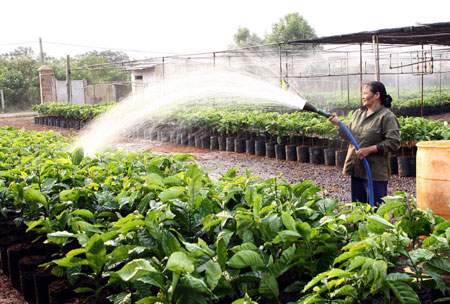Experimental model of catimor coffee coffee renovation
Group of engineers Nguyen Quoc Cuong, masters of Doan Nhan Ai and Dang Van Cung in A Luoi District Agriculture and Rural Development Department, Thua Thien-Hue province, have successfully experimented with catimor coffee improvement model (one type tea coffee) in A Luoi district by means of cutting trees, recovering and improving crop productivity.
The method that the engineering team offered is to cut branches, "rejuvenate" the area of coffee after a period of exploitation.
The model is implemented in Nham commune, A Luoi mountainous district, on an area of 3.5 ha, density of 5,000 trees / ha. Cutting techniques are carried out in old and low-yield coffee gardens, conducting a sawing process 25-30cm above the ground, according to the inclined plane, the cutting surface is smooth, not crushed.

Take care of coffee seedlings.(Photo: Tran Tuan / VNA)
After sawing the coffee tree, the thinning engineers shade the shade so that the light shines on the garden. About 20 days after cutting, sprouting coffee shoots are kept to be evenly distributed on a root; At the same time, apply care methods such as for first-time coffee gardens (weeding, fertilizing, applying plant protection measures .)
According to engineer Nguyen Quoc Cuong, the project leader, in A Luoi, if the coffee tree was cut in March every year, it would be very convenient for disease prevention on saws and the time when the trees were turned on in April. . At this time, in the afternoon, there is often thunderstorm carrying lots of sodium, favorable for the development of new shoots and branches.
After sawing about 18 months, coffee plants harvest. Coffee after the first renovation in Nham commune, A Luoi district has yielded 4.9 tons of fresh coffee / ha; This productivity may be higher in the following crops if well cared for.
Model of catimor coffee garden improvement by recovery sawing method suitable to local conditions, easy to implement and less expensive.
A Luoi has about 1,000 ha of catimor coffee growing; including concentrated farm production coffee and scattered in households in the area; in which 300ha has passed the exploitation and degradation cycle, productivity is low, only about 1 ton of fresh coffee / ha.
Many farmers want to break down the coffee area to plant other trees. Therefore, the recovery and improvement of coffee productivity makes sense in improving income, improving living standards for ethnic minority people in the area. This model needs to be replicated in the mountainous district of A Luoi in the future.
- Tea coffee brings many benefits to the people
- 10 facts about coffee
- How to make a perfect cup of coffee?
- Around the world with 31 types of coffee
- Why are only some places growing the best coffee in the world?
- Applying technology in Mercedes cars, people have created the best coffee filter in the world
- How much does your habit of drinking coffee consume?
- Strange: Tea made from extremely good coffee for health
- Things that can replace bright coffee cups
- The coffee has enough flavor but is not bitter and not made from coffee beans
- How does coffee affect human health?
- Why do so many people like to add sugar to coffee?
 'Barefoot engineer' invents a pipeless pump
'Barefoot engineer' invents a pipeless pump Process of handling dead pigs due to disease
Process of handling dead pigs due to disease Radiometer
Radiometer Warp Engine: Technology brings us closer to the speed of light
Warp Engine: Technology brings us closer to the speed of light